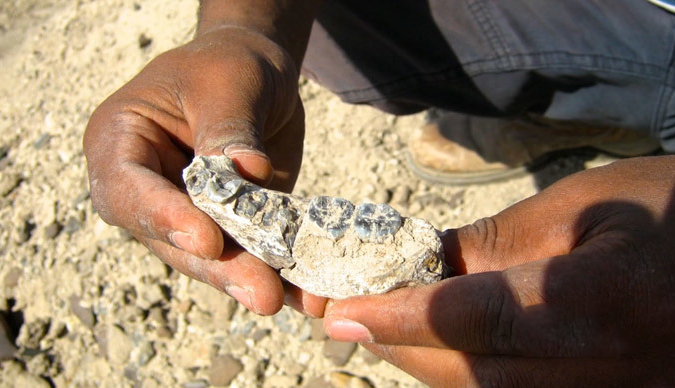A newly discovered fossil has shaken up science’s view of human evolution and could be the missing link between apes and humans: 400,000 years older than the oldest human bone found, the discovery could entirely rewrite our story.
For decades scientists have been stumped on the gap between humans that walked bent over and those that walked upright. Who was the mysterious ancestor that joined the ape-like Australopithecus with the human-like Homo? We could be looking at an answer. It now appears the timeline for earliest upright humans goes back not to 2.3 – but to 2.8 million years.
An Ethiopian student at Arizona State University and an accompanying research team discovered the lower jawbone and five teeth in Ethiopia in 2013
The fragments definitely belong to the Homo lineage (of which we are the only remainder), but scientists are puzzled about what the species exactly is. In fact, it could turn out to be a completely new one.
Found 250 miles from Addis Ababa, the fragments are believed to belong to our ancestor from when the current dry land was still wetlands, interspersed with trees providing shade and rivers nourishing them. It was discovered not too far from another famous find – Lucy, the ape-like Austrolapithecus afarensis, known to be the earliest potential ancestor of the human family.
That transition between the two types is the first time in our history we switched from bashing things with rocks to actually using our brains to solve puzzles, although there was another transitional type – the crude and less brainy Paranthropus – thought to have appeared just before the transition to Homo.
“There is a big gap in the fossil record between about 2.5 million and 3 million years ago — there’s virtually nothing relating to the ancestors of Homo from that time period, in spite of a lot of people looking,” study co-author and one of the leaders of the team, Brian Villmoare of the University of Nevada, told Live Science.
Now, for the first time, the 700,000-year hole between Lucy-like and Homo-type humans is beginning to fill up with information.
“This is a little piece of the puzzle that opens the door to new types of questions and field investigations that we can go after to try to find additional evidence to fill in this poorly known time period,” ASU Institute of Human Origins director William H. Kimbel said in the press release.
“It’s an excellent case of a transitional fossil in a critical time period in human evolution,” he added.
The nature of the new find is not without its naysayers: some scientists have posited that the fossil actually belongs to the well-known species of Homo habilis –the earliest known member of the Homo lineage. But careful digital processing has shown that these are not Homo habilis fragments and they in fact belong to a creature that came shortly before it.
It took years for scientists to get to where they are now. The research started in 2002 with painstaking surveying. The scientists were careful not to disturb anything unnecessarily. “So it took us basically 13 years to find this [human ancestor]. It doesn’t mean that the work that we did was wasted up until that time. But when we did find this [jaw], we were pretty excited that after all this time it actually worked out,” assistant professor and co-author Chris Campisano said.
The expectation was that if they were to dig around the area, they would find Lucy’s contemporaries – not what looked like the missing link.
“We first started collecting fossils in the area around where the jaw was eventually found in 2012,” Campisano went on. “When we realized how old the sediments were, we thought we might be able to find more specimens of Lucy’s species and figure out what happened to that lineage. Instead, we were rewarded with a much more exciting discovery.”
“Honestly, it was an exciting moment…I had good experience in field surveying and knew where potential sediments are. I climbed up a little plateau and found this specimen right on the edge of the hill,” said Chalachew Seyoum, the student behind the find.
What we know for sure, according to Professor Kaye Reed of ASU, is that the creature walked on two legs and lived in eastern Africa. Diet and tool use are very important logical next steps to understanding just how clever this ancestor was.
The research continues at ASU for other fossils around the same area to find answers to those questions.
RT
Maher Taki

